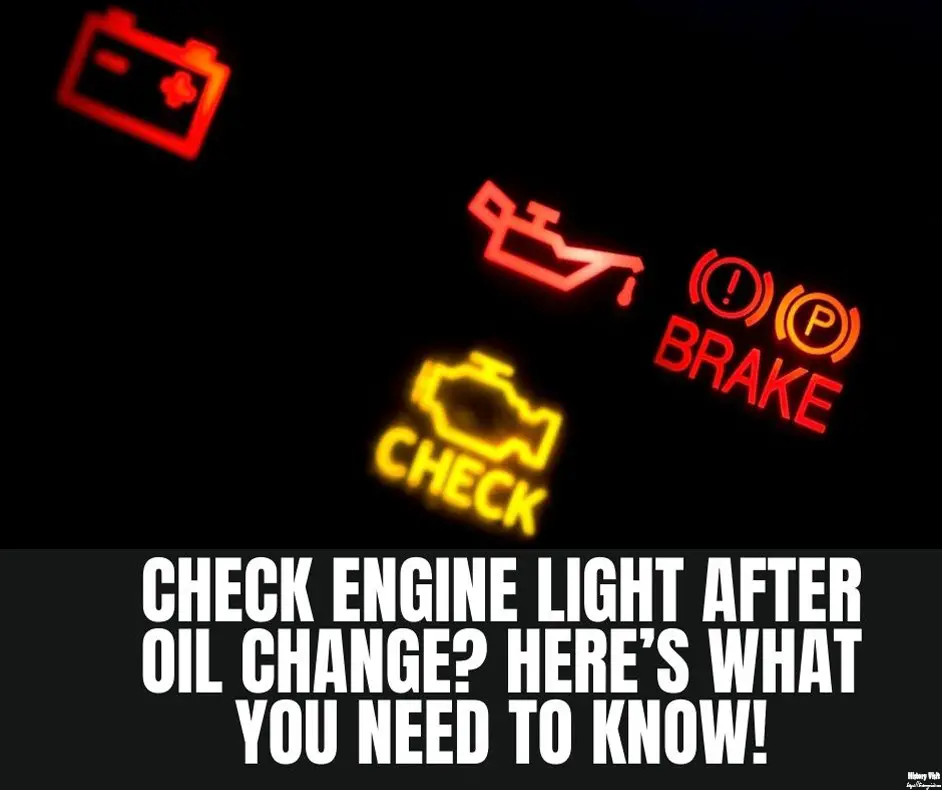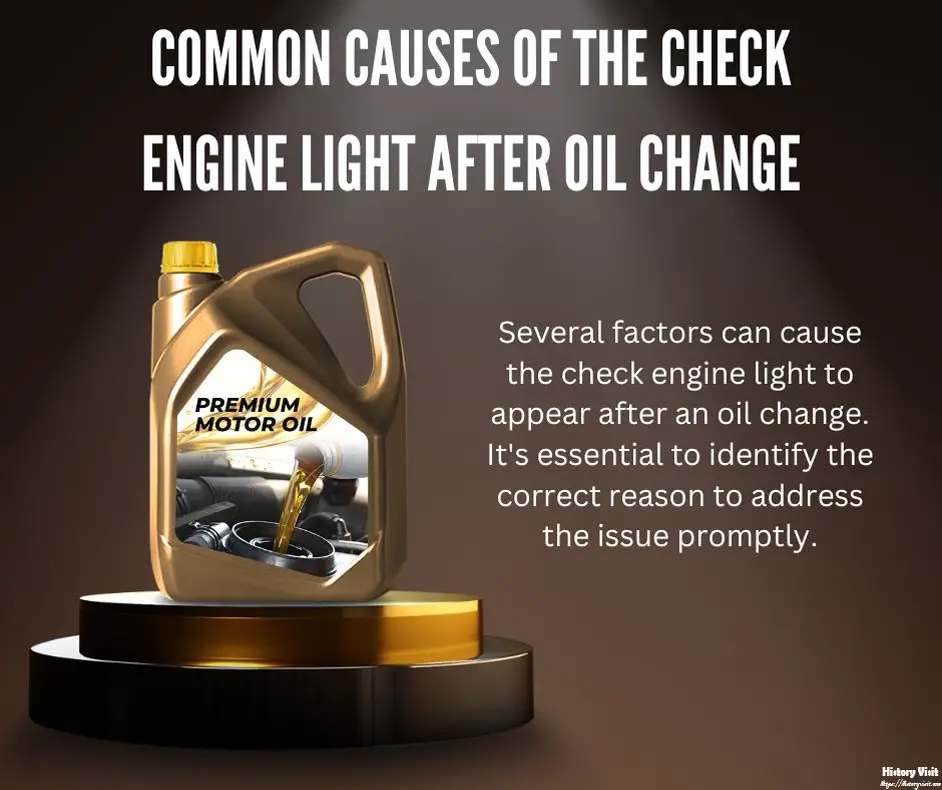Check Engine Light After Oil Change? What You Need to Know!

Introduction
Experiencing a check engine light after oil change can be alarming. Many car owners expect their vehicle to run smoothly post-maintenance. However, seeing that dreaded light can cause immediate concern. It’s crucial to understand why this happens and how to address it.
A check engine light after oil change doesn’t always indicate a severe problem. Various reasons could trigger this warning. From minor issues to more serious concerns, the causes can vary. Knowing the potential reasons helps in managing the situation effectively.
In this article, we will explore the reasons behind the check engine light after oil change. We will discuss the common causes, troubleshooting steps, and preventive measures. Understanding these aspects can help you maintain your vehicle better and avoid unnecessary stress.
Common Causes of the Check Engine Light After Oil Change

Several factors can cause the check engine light to appear after an oil change. It’s essential to identify the correct reason to address the issue promptly.
Oil Change Mistakes (Check Engine Light After Oil Change)
Sometimes, errors made during the oil replacement process can trigger the check engine light. An incorrect oil filter or the wrong type of oil can cause problems. Ensuring that the correct parts and fluids are used is crucial. Double-checking these aspects can prevent issues.
Sensor Issues
Modern vehicles rely on numerous sensors to monitor various systems. A malfunctioning sensor can trigger the check engine light. For instance, the oil pressure sensor might detect an issue if it’s faulty or improperly connected. Checking and resetting sensors can resolve this.
Loose or Unconnected Components
During an oil change, various parts are handled. If a component is left loose or disconnected, it can cause the check engine light to turn on. Ensuring all components are securely reconnected after the oil change is vital. A thorough inspection can help identify and fix such issues.
Excess Oil Spillage
Sometimes, oil can spill onto the engine components during an oil change. This spillage can cause sensors to malfunction or get damaged. Cleaning any excess oil and ensuring proper handling during the oil change can prevent such problems.
Troubleshooting the Check Engine Light After Oil Change
If the check engine bulb appears after an oil change, specific steps can help troubleshoot the issue. Following these steps methodically can pinpoint the problem and provide a solution.
Check for Obvious Issues (Check Engine Light After Oil Change)
Start by checking for any obvious issues. Look for loose or disconnected components. Ensure the oil filter and drain plug are securely fastened. Verify that the correct oil and oil filter were used during the change. These initial checks can often resolve the problem quickly.
Scan for Error Codes
Using an OBD-II scanner can help identify the exact reason for the check engine light. The scanner reads error codes stored in the vehicle’s computer. These codes provide specific information about the issue. Addressing the indicated problem can often clear the check engine light.
Reset the Check Engine Light
In some cases, resetting the check engine light might resolve the issue. This can be done using an OBD-II scanner. If the light returns after resetting, further investigation is needed. A persistent light indicates an underlying problem that requires attention.
Inspect Sensors and Connections
Inspect all sensors and their connections for any signs of damage or loose connections. The oil pressure sensor and other related sensors should be checked thoroughly. Reconnecting or replacing a faulty sensor can resolve the check engine light issue.
Preventive Measures to Avoid Check Engine Light After Oil Change
Taking preventive measures can help avoid the check engine light after oil change. Ensuring proper procedures and attention to detail during the oil change can make a significant difference.
Use the Correct Oil and Filter
Always use the recommended oil and oil filter for your vehicle. Refer to the owner’s manual for the correct specifications. Using the wrong type of oil or filter can cause issues and trigger the check engine light.
Follow Proper Procedures
Adhering to the correct procedures during an oil change is essential. Ensure you cool down the engine before starting. Drain the old oil completely and replace the oil filter properly. Following these steps can prevent common issues.
Check for Leaks and Spills
After completing the oil change, check for any leaks or oil spills. Clean any excess oil on the engine components. Ensuring there are no leaks or spills can prevent sensor malfunctions and check engine light issues.
Regular Maintenance
Regular vehicle maintenance can prevent many issues, including check engine light problems. Follow the recommended maintenance schedule for your vehicle. Regular checks and servicing keep your vehicle in optimal condition and reduce the risk of unexpected issues.
When to Seek Professional Help (Check Engine Light After Oil Change)
Sometimes, despite troubleshooting, the check engine light remains on. Knowing when to seek professional help is crucial. A professional mechanic can provide expert diagnosis and solutions.
Persistent Check Engine Light
If the check engine light persists despite troubleshooting, it’s time to consult a professional. A mechanic has the tools and expertise to diagnose the issue accurately. They can address underlying problems that might not be apparent.
Complex Issues
Some issues causing the check engine light can be complex. Problems with the vehicle’s computer system or wiring might require professional intervention. A trained mechanic can handle these complex issues effectively.
Preventing Further Damage
Ignoring a persistent check engine light can lead to more significant problems. Seeking professional help early can prevent further damage to the vehicle. Addressing the issue promptly ensures your vehicle’s longevity and performance.
Conclusion
A check engine light after oil change can be concerning. Understanding the potential causes and troubleshooting steps can help manage the situation effectively. Ensuring proper procedures during an oil change and regular maintenance can prevent such issues.
If the check engine light persists, seeking professional help is advisable. A mechanic can provide accurate diagnosis and solutions. Proper care and attention to your vehicle’s needs can keep it running smoothly.
Remember, a well-maintained vehicle is crucial for safety and performance. Addressing issues like the check engine light promptly ensures a reliable and enjoyable driving experience.


